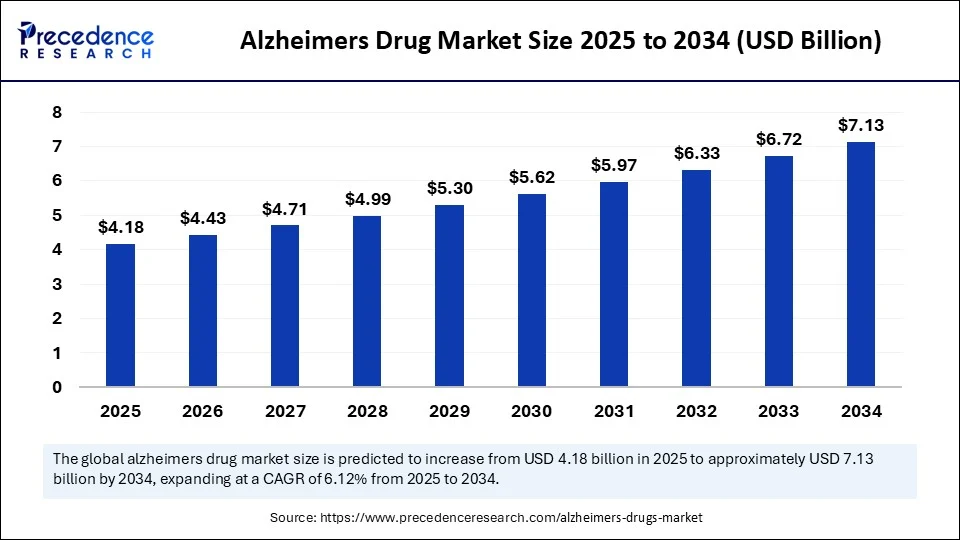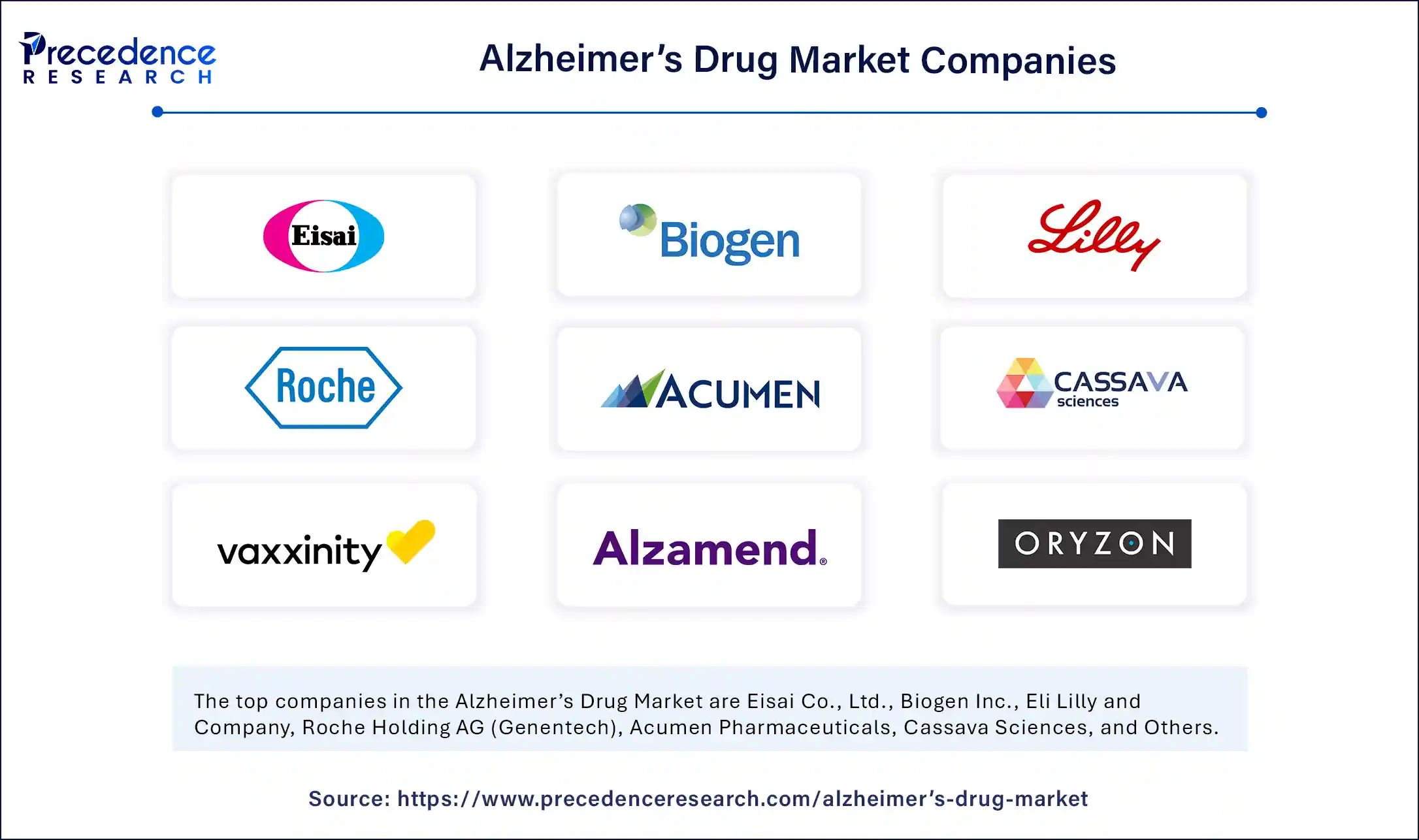This growth is driven by breakthroughs in targeting key pathological hallmarks—β-amyloid and tau—alongside a surge in clinical pipelines exploring neuroinflammation, synaptic protection, and metabolic pathways. The entry of antibody therapies and small molecules capable of slowing cognitive decline for the first time marks both a milestone and a turning point for pharmaceutical investment in neurodegenerative disorders.

Alzheimer’s Drug Market Key Points
-
The global Alzheimer’s drug market was valued at USD 3.94 billion in 2024 in terms of revenue.
-
It is projected to reach USD 7.13 billion by 2034.
-
The market is anticipated to grow at a CAGR of 6.12% from 2025 to 2034.
-
North America led the global market, accounting for a 47% share in 2024.
-
Asia-Pacific is expected to register the fastest CAGR during the forecast period.
-
By drug class, anti-amyloid monoclonal antibodies held the largest share of 44% in 2024.
-
The tau aggregation inhibitors segment is projected to grow at a remarkable CAGR from 2025 to 2034.
-
By disease stage, the severe Alzheimer’s segment dominated the market with a 48% share in 2024.
-
The early-stage / mild Alzheimer’s segment is forecasted to grow at a notable CAGR over the coming years.
-
By mechanism of action, the amyloid beta inhibitors segment held the largest market share of 46% in 2024.
-
The tau protein modulators segment is expected to expand at a remarkable CAGR between 2025 and 2034.
-
By drug type, biologics led the market, capturing a 55% share in 2024.
-
The small molecules segment is expected to grow at a noteworthy CAGR during the forecast period.
-
By distribution channel, hospital pharmacies accounted for a 42% market share in 2024.
-
The online pharmacies segment is projected to grow at a strong CAGR between 2025 and 2034.
-
By end user, specialty clinics and neurology centers held a 39% market share in 2024.
-
The homecare settings segment is anticipated to register significant growth over the forecast period.
Alzheimer’s Drug Market Growth Factors
Several long-term factors are fueling this market’s expansion. First, global population aging is increasing Alzheimer’s prevalence, with the number of affected adults projected to reach over 150 million by 2050. Second, societal awareness of dementia and better diagnostic tools like PET scans, plasma biomarkers, and cognitive assessments are enlarging the treatable pool and enabling earlier patient entry.
Third, regulatory incentives such as breakthrough therapy designations and accelerated approvals are encouraging investment in novel therapies. Moreover, improved reimbursement models, including outcomes-based pricing, are reducing payer hesitancy, spurring uptake of high-cost biologics and small molecules.
Role of AI in the Alzheimer’s Drug Market
Artificial intelligence is revolutionizing Alzheimer’s drug development and patient care pathways. In research, AI-driven platforms accelerate target discovery by analyzing genetic, proteomic, and clinical data to reveal novel disease mechanisms. Virtual screening powered by machine learning reduces screening time for new compounds.
In clinical trials, AI enhances patient stratification, predicting responders and reducing enrollment timelines. AI also supports remote monitoring through speech and cognitive pattern analysis, enabling earlier detection of cognitive decline and more nimble trial design. Post-approval, AI assists in implanting decision-support algorithms within electronic health records to improve diagnostic accuracy and guide real-world treatment management.
Regional Outlook
North America leads the market, supported by robust R&D ecosystems, advanced diagnostics, and early payer coverage for amyloid-targeted drugs.
Europe follows closely; several countries have fast-track approval processes for neurodegenerative treatments, and centralized healthcare systems enable coordinated care pathways.
Asia-Pacific is emerging as the fastest-growing region as aging populations rise in China, Japan, and Korea; the rollout of biomarker testing and increased healthcare investment are supporting adoption.
Latin America, Middle East & Africa lag behind due to infrastructural and diagnostic limitations, but many countries are prioritizing dementia in national health plans and building capacity via global partnerships.
Alzheimer’s Drug Market Dynamics
Market Drivers
The market is primarily being driven by two major forces. The first is scientific innovation — driven notably by the approval of monoclonal antibodies targeting amyloid plaques, and promising results from anti-tau and neuroprotective agents. The second is policy and payer alignment.
Governments and insurers increasingly value disease-modifying potential, especially if early intervention delays or avoids institutionalization, making high-cost therapies economically viable. Additionally, global initiatives for dementia research funding and the growing involvement of CROs and academia in collaborative trials are boosting the pipeline and commercial prospects.
Opportunities
Significant opportunities are emerging across the Alzheimer’s market landscape. Small-molecule oral therapies that are less expensive and more accessible could sustainably increase treatment reach. Biomarker-driven early intervention in asymptomatic individuals offers potential for preventative treatments. Combination regimens targeting multiple pathologies simultaneously such as combined anti-amyloid and anti-tau approaches are expected to elevate efficacy.
AI-enabled tools for tracking cognitive function and treatment response pave the way for digital therapeutics that enhance drug utility. Additionally, emerging markets—where aging populations and dementia prevalence are rising present expansion opportunities, provided diagnostic and treatment infrastructure can be built.
Challenges
The Alzheimer’s drug market faces significant challenges. The complexity of the disease has led to high failure rates in clinical trials, which can dampen investor appetite. First-generation therapies carry risks like amyloid-related imaging abnormalities (ARIAs), prompting cautious adoption. High prices and uncertain long-term benefits can trigger payer scrutiny and restrict access.
Regulatory divergence across countries complicates global launch strategies. Diagnostic access remains a hurdle biomarker tests and PET scans are not uniformly available, particularly in low- and middle-income countries. Lastly, patient and caregiver adherence to infusible or injectable regimens presents practical hurdles in real-world use.
Alzheimer’s Drug Market Scope
| Report Coverage | Details |
| Market Size by 2034 | USD 7.13 Billion |
| Market Size in 2025 | USD 4.18 Billion |
| Market Size in 2024 | USD 3.94 Billion |
| Market Growth Rate from 2025 to 2034 | CAGR of 6.12% |
| Dominating Region | North America |
| Fastest Growing Region | Asia Pacific |
| Base Year | 2024 |
| Forecast Period | 2025 to 2034 |
| Segments Covered | Drug Class, Disease Stage, Mechanism of Action, Drug Type, Distribution Channel, End User and Region |
| Regions Covered | North America, Europe, Asia-Pacific, Latin America, and Middle East & Africa |
Alzheimer’s Drug Market Companies

- Eisai Co., Ltd.
- Biogen Inc.
- Eli Lilly and Company
- Roche Holding AG (Genentech)
- Acumen Pharmaceuticals
- Cassava Sciences
- Vaxxinity Inc.
- Anavex Life Sciences
- Alzamend Neuro
- Oryzon Genomics
Segments Covered in the Report
By Drug Class
- Cholinesterase Inhibitors
- Donepezil
- Rivastigmine
- Galantamine
- NMDA Receptor Antagonists
- Memantine
- Combination Drugs
- Donepezil + Memantine
- Anti-Amyloid Monoclonal Antibodies
- Lecanemab (Leqembi)
- Aducanumab (Aduhelm)
- Donanemab (under review)
- Tau Aggregation Inhibitors
- Others
- Anti-inflammatory drugs
- Insulin resistance modulators
- Neuroprotective agents
By Disease Stage
- Early Stage / Mild Alzheimer’s
- Moderate Alzheimer’s
- Severe Alzheimer’s
- Prodromal / Mild Cognitive Impairment (MCI)
By Mechanism of Action
- Amyloid Beta Inhibitors
- Tau Protein Modulators
- Neurotransmitter Modifiers
- Anti-inflammatory Agents
- Others
- Mitochondrial stabilizers
- Synaptic function enhancers
By Drug Type
- Biologics
- Small Molecules
By Distribution Channel
- Hospital Pharmacies
- Retail Pharmacies
- Online Pharmacies
By End User
- Hospitals
- Specialty Clinics & Neurology Centers
- Homecare Settings
- Academic & Research Institutions
Read Also: Esophageal Cancer Market
You can place an order or ask any questions, please feel free to contact at sales@precedenceresearch.com|+1 804 441 9344
- Arteriovenous Implants Market Enhance dialysis outcomes with advanced grafts, endovascular access, and AI-assisted precision - September 16, 2025
- Smart Retinal Implants Market Restore vision with wireless bioelectronic prosthetics and AI-powered retinal technologies - September 16, 2025
- Myopia Treatment Devices Market Size to Reach USD 38.51 Billion by 2034, Growing at a CAGR of 7.86% - September 1, 2025
